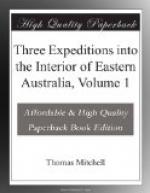A NATIVE VILLAGE OF BOWERS.
In crossing one hollow we passed among the huts of a native tribe. They were tastefully distributed amongst drooping acacias and casuarinae; some resembled bowers under yellow fragrant mimosae; some were isolated under the deeper shades of casuarinae; while others were placed more socially, three or four together, fronting to one and the same hearth. Each hut was semicircular, or circular; the roof conical, and from one side a flat roof stood forward like a portico, supported by two sticks. Most of them were close to the trunk of a tree, and they were covered, not as in other parts, by sheets of bark, but with a variety of materials, such as reeds, grass, and boughs. The interior of each looked clean and to us, passing in the rain, gave some idea not only of shelter, but even of comfort and happiness. They afforded a favourable specimen of the taste of the gins, whose business it usually is to construct the huts. This village of bowers also occupied more space than the encampments of native tribes in general; choice shady spots seemed to have been an object, and had been selected with care.
EFFECT OF SUDDEN MOISTURE ON THE WHEELS.
We had at length been able to turn westward, keeping the river trees in view when, the rain continuing, we began to experience the effects of moisture on the felloes of the wheels. The heat and contraction had lately obliged us to tighten and wedge them to such a degree that now, when the ground had become wet, the expansion of the whole broke the tirering of the wheel. Having no forge we could only attempt the necessary repairs with a common fire, and for this purpose I left three men with Mr. White; and I resumed the journey with the rest of the party. The rain continuing, the soft ground so clogged the wheels that the draught was very distressing to the bullocks. We pursued a westerly direction for five miles over ground thinly wooded, with patches of open plain. Changing our course to 60 degrees west of north, we traversed a very extensive tract of clear ground until, after crossing four miles and a half of it, we reached a bend of the river, and at three P.M. encamped on an open spot a quarter of a mile from it. At five o’clock the other cart came up, having been substantially repaired, by taking off the ring, shortening the felloes, closing them on the spokes, and then replacing the ring again by drilling two holes through it.
January 11.
Pursuing a westerly course I found the river on my right at five miles. At a mile further it crossed my intended line of route, and obliged me to turn south-south-west, in which direction we intercepted the junction of the dry river, named Kareen, which we crossed on the 8th instant. The bed above the junction was narrow but deep, and the permanent character of its banks gave to this channel the appearance of a considerable tributary, which it probably may be at some seasons, although then dry. In a section of the bank near the junction, I observed a bed of calcareous tuff. The passage of this channel was easiest for the carts at the spot where it joined that of the Gwydir. We travelled, after crossing, along the north-western skirts of extensive open plains, and thus reached, at five miles further, another line of trees, enclosing a chain of ponds, on which we encamped, after a journey of twelve miles.




